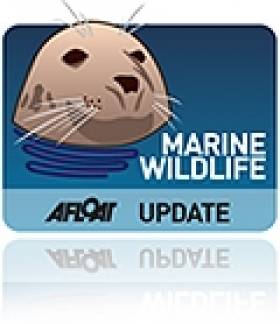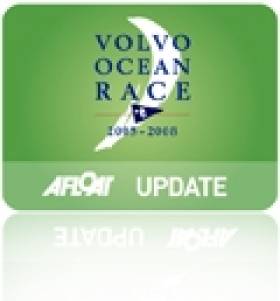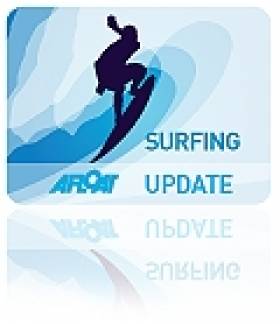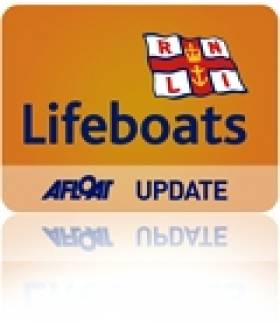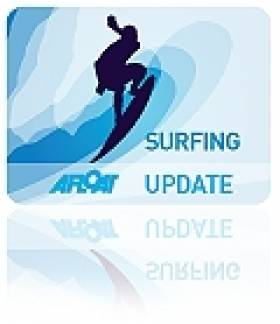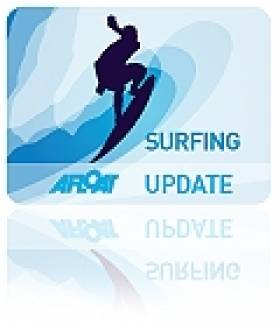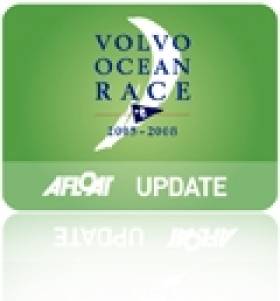Displaying items by tag: video
Video: Courting Humpback Whales Duel Off Baltimore
#MarineWildlife - Check out this wonderful video - via the Baltimore Photos Facebook page - of two male humpback whales fighting over a prospective female partner off West Cork late last year.
Richard O'Flynn, who posted the footage to YouTube, says: "We were following two humpbacks for about 30 minutes when a third one turned up.
"What you're seeing here is the female to the right of the shot and her partner between her and the third humpback trying to keep him away from her. It went on for about one-and-a-half hours!"
O'Flynn said it was only his second time using the video camera "so please forgive the shake... and I was driving the boat at the same time!"
Rosslare RNLI Launches To Drifting Vessel In Severe Winds
#RNLI - The volunteer lifeboat crew with Rosslare Harbour RNLI launched at 10.30am on Wednesday morning (6 February) to a fishing vessel drifting dangerously close to the shore in a force 8 gale (see video below).
The vessel was located about a mile from the lifeboat station in Rosslare Harbour and the lifeboat was on scene within minutes.
Two volunteer lifeboat crew were transferred to the drifting vessel whose moorings were unable to hold due to an unexpected change in the wind direction, and brought it under control in severe weather conditions.
The vessel was brought safely to the main harbour and secured. The callout last just over two hours.
Commenting on the callout, Rosslare Harbour RNLI deputy launching authority David Maloney said: "Weather conditions this morning in Rosslare Bay were very challenging and the crew showed great skill in bringing the vessel to safety.
"If the lifeboat had not launched, I have no doubt that the vessel would have been washed ashore."
First Candidates For All-Female VOR Team Sail to Lanzarote
#VOR - The first candidates for places on Team SCA's all-female team for the next edition of the Volvo Ocean Race are currently sailing on a training leg from Southampton to Lanzarote.
The Volvo Ocean Race website spoke to one of the hopefuls, Vendee Globe veteran Sam Davies, who described the team's plans to field the first women-only team in the VOR as "an amazing opportunity for me and woman's sailing in general, especially for women ocean racers."
She's joined on the VOR 70 training vessel - which sports the team's recently unveiled livery ahead of the completion of their VOR 65 yacht - by fellow Brit sailor Annie Lush, Carolijn Brouwer and Klaartje Zuiderbaan from the Netherlands, Jeanne Gregoire from France, and Liz Wardley and Stacey Jackson from Australia.
Davies said of the team selection that it's "a two-way process... the managers are looking at all of us and we're testing it out to see if it is really what we want to do."
Team SCA managing director Richard Brisus said of the first trainee voyage to the team's base at Puerto Calero: "We have set out to work with the world’s best female offshore sailors and create a strong group of women that also has the ability to work well together as a high-performing team."
A second group of candidates will head out to sea shortly, and Team SCA coach Magnus Olsson said it "would be fantastic if we could find our team from these two groups.
“They are a remarkable group of women and each brings a very high level of skill sets to a potential team."
Surfing Ireland's 'Emerald Slabs' Caught On Video
#Surfing - Check out this stunning video of Portuguese surf pro Nic Von Rupp who cancelled his winter trip to Hawaii last week to take on what Surfer magazine calls 'Ireland's Emerald Slabs'.
Towing out to the storm-fuelled swells of Mullaghmore, Von Rupp shows just how it's done as the world's big wave surfing elite flocked to Sligo for the Billabong Tow-In Session.
Lifeboat Rescues Windsurfer In Stormy Conditions
#RNLI - Kilkeel RNLI rescued a windsurfer who got into difficulty in Carlingford, Co Louth yesterday (Tuesday 29 January).
The charity’s volunteer lifeboat crew was requested to launch by the Irish Coast Guard shortly after 2pm following a report that a windsurfer had got into difficulty in Carlingford Lough.
Launching their inshore lifeboat immediately, the crew encountered very unfavourable weather, with strong westerly winds of between force six and seven.
The lifeboat proceeded up the lough where they found and retrieved the windsurfer who had stayed by his board. The crew then attempted to retrieve the sail and board but couldn’t due to the windy weather conditions. They instead proceeded to tow the board into Greenore where the local coastguard took over.
Despite being in the water for approximately an hour, the casualty was described as being in reasonably good health.
Roy Teggarty, Kilkeel RNLI lifeboat operations manager, paid tribute to the lifeboat crew for their efforts in what was a challenging rescue:
"This was a day with difficult conditions because of the strong winds," he said. "It was mainly difficult to keep the lifeboat steady when retrieving the casualty so this rescue involved expert boat handling by all involved."
Surf Record Breaker Garrett McNamara Rides '100ft Wave'
#Surfing - Garrett McNamara has done it again - after riding what is claimed to be the largest wave ever surfed.
Last summer on Afloat.ie we reported that the Irish-American surfing pro had his previous world record attempt - a 78-foot monster off Portugal in November 2011 - confirmed by Guinness record-keepers.
But the Hawaiian wasn't content to rest on his laurels, and on a recent return visit to Nazaré he is said to have smashed his own record with a wave reported to be as much as 100ft in height.
The Guardian has video of McNamara's incredible attempt which you can view below - it's a sight that beggars belief!
McNamara's previous tow-in surf at Nazaré earned him the Biggest Wave title at the 2012 Billabong XXL Big Wave Awards. He shared his $15,000 prize money with Devon surfer Andrew 'Cotty' Cotton, who towed him by personal watercraft into the massive swell.
"Everything was perfect, the weather, the waves," said Northern Irish surfer Al Mennie, who was on hand to witness the pair at Praia do Norte.
Big Waves Come to Mullaghmore After Long Wait
#Surfing - Some of the world's top big wave surfing talent enjoyed the 'day that almost never was' at Mullaghmore in Sligo on Sunday.
As the video above shows, competitors in the long-delayed Billabong Tow-In Session finally got a chance to prove their mettle after two amber alerts in a week for the international event, pushed back from last year after a calm storm season.
Confidence was high as the storm front that has been battering Ireland for the past two days made its way across the Atlantic, bringing with it the giant swells needed to green-light the action.
Big wave surfers being secretive sorts, due to the dangerous nature of offshore tow-in surfing and their determination to keep their favourite spots 'just for them', we don't yet have results of the action, or even confirmation that the waves were big enough to count!
But what we do know is that the likes of Billabong XXL 2013 Ride of the Year nominee Peter Conroy were present and ready to tackle the colossal walls of water Mother Nature was set to provide.
Meanwhile, Met Eireann warns that gale force winds are expected to continue today (29 January) with southwesterly gusts of up to 110 km/h possible. Those in coastal areas have been warned to exercise caution.
Lightness, Strength and Rigidity Key to New VOR 65 Design
#VOR - In the latest video update following the construction of the Volvo Ocean Race's new one-design yacht, VOR expert Rick Deppe travels to the Decision plant in Lausanne, Switzerland to take a look at the production of the boat's internal structure.
The new footage shows the 'sandwich' construction of the lightweight internal frame of foam and carbon fibre which will give the yachts the strength and rigidity that will make them both fast and safe on the open sea.
Previously the series visited the USA, Italy and France for an all-round catch-up on the progress of the new VOR 65 design.
Fans of the Volvo Ocean Race should expect a "very forward thinking" design when the finished boat is finally unveiled ahead of the next edition of the round-the-world race.
As reported on Afloat.ie last week, Team SCA have unveiled the livery for their VOR 65 which they intend to launch when ready to race later this year.
Tangled Dolphin Seeks Help From Divers
#MarineWildlife - The Irish Examiner reports on the extraordinary story of a bottlenose dolphin who turned to a group of divers for help to free it from a fishing line.
The video above captures the touching scene when the cetacean approached the divers as they filmed a group of manta rays in the Pacific waters near Kona in Hawaii.
As the footage shows, the dolphin positioned itself in such as way as to allow diver Keller Laros to cut the fishing tackle that was tangled tightly around its midsection and remove the hook from its left pectoral fin.
After the dolphin took to the surface for a quick breather, the divers were able to free it from the line and allow it to swim away unharmed.
Pro Kitesurfer Ruben Lenten Gets Big Air In Ireland
#Kitesurfing - Another video for this chilly day, this time of professional kitesurfer Ruben Lenten as he takes it to the extreme in Ireland and the Netherlands.
The footage on YouTube shows the Red Bull team member getting some big winter air off the west coast of Ireland - and storm chasing closer to home off the Dutch coast. Better him than us!


























